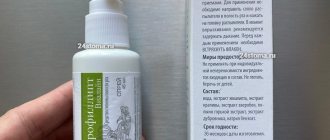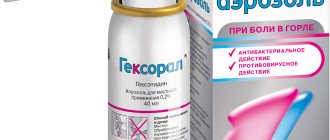Pharmacological properties of the drug Chlorophyllipt
Chlorophyllipt belongs to the pharmacotherapeutic group of antiseptic drugs. The drug has an antibacterial (bactericidal and bacteriostatic) and etiotropic effect against resistant and sensitive staphylococci to antibiotics. It has the ability to eliminate plasmids of resistance of various bacterial pathogens to antibiotics, increases the oxygen content in tissues, and has a pronounced detoxifying effect, therefore the drug is used in conditions of reduced natural defenses of the body, as a means of combating tissue hypoxia and to increase the effectiveness of antibacterial drugs used. An experimental study of chlorophyllipt revealed the tropism of this drug for lung tissue, and the absence of any carcinogenic, mutagenic, teratogenic and embryotoxic effects. The bactericidal concentration of chlorophyllipt in the blood is created by the simultaneous intravenous administration of 8 ml of a 0.25% solution, the bacteriostatic concentration is created by 4 ml of a 0.25% solution. The therapeutic concentration lasts for an average of 6 hours; the optimal dose is to administer the drug 4 times a day.
Chlorophyllipt for gargling: how to dilute
An alcohol solution of Chlorophyllipt is often recommended for gargling.
The drug does have moderate antimicrobial activity, but only against staphylococci. This means that it makes sense to use the drug only, for example, for purulent tonsillitis (in this case, staphylococcus will actually be sown in the microflora). For other bacteria that cause inflammation of the tonsils and throat, rinsing with Chlorophyllipt will only have a slight deodorizing effect. How to dilute Chlorophyllipt for gargling - instructions for using the drug for throat recommend diluting 1 teaspoon of Chlorophyllipt alcohol solution in half a glass of warm boiled water. Moreover, you need to rinse your mouth for 5 minutes per procedure (since the drug is quite weak). Those. During the procedure, you will need to repeatedly draw up and spit out the diluted solution of the drug. Rinsing is carried out 3-4 times a day, preferably no more than 4-5 days.
Such a modest duration of use is due to the fact that alcohol solutions greatly dry out the oral mucosa and lead to its thinning. In addition, please note that the alcohol form of the drug is prohibited for use in children under 18 years of age. In fact, we would never recommend that anyone rinse their mouth with an alcohol solution of this drug. If you decide to use it, then it is better to use Chlorophyllipt spray, which does not contain alcohol. Due to the absence of alcohol, the spray can be used for a long time and often, and besides, the drug does not require dilution and is ready for use.
Chlorophyllipt in lozenges –
Chlorophyllipt for the throat in the form of an alcohol or oil solution has another alternative. These are Chlorophyllipt tablets for resorption. They are produced by two Russian manufacturers. Firstly, these tablets (Russia) are produced in 0.025 g (20 tablets per package) at a price of 120 rubles. The second, which produces lozenges of 0.8 g (20 tablets per package) at a price of 140 rubles.
Indications for use of the drug Chlorophyllipt
Staphylococcal septic conditions (postpartum, postoperative, postinfectious), purulent-inflammatory and postoperative complications of staphylococcal etiology: with burn disease, staphylococcal endocarditis, pneumonia, lung abscess, pleurisy, peritonitis, osteomyelitis, para- and metroendometritis, post-abortion sepsis, as well as acute and subacute inflammatory diseases of the internal genital organs not associated with childbirth or abortion, purulent-destructive forms of pyelonephritis and urosepsis (as part of complex therapy). For diseases caused by non-staphylococcal antibiotic-resistant pathogens (in particular for the treatment of erysipelas, tuberculosis of various localizations, listeria infection). Diseases of the upper respiratory tract (tonsillitis, pharyngitis, laryngitis), as well as aphthous and ulcerative stomatitis.
Chlorophyllipt: price and composition analysis
For Chlorophyllipt spray the price for 2021 will be about 210 rubles (for a 45 ml bottle equipped with a spray nozzle). The cost of a 2% oil solution will be from 150 rubles per 20 ml bottle. For a 1% alcohol solution of Chlorophyllipt, the price starts from 240 rubles (for a 50 ml bottle). As for lozenges, the cost of 1 package of 20 tablets starts from 150 rubles.
The drug Chlorophyllipt is produced by several manufacturers, but regardless of this, the main component of the drug always remains the extract of eucalyptus leaves - in the form of essential oil. The value of eucalyptus oil is determined by the content of a substance called “Cineol”, which gives the drug an antimicrobial and expectorant effect. Some other properties of this drug, which are beautifully described in the instructions (for example, accelerating wound healing) do not have much therapeutic value, because This effect of the drug is rather weak.
It should be noted that the content of cineole in eucalyptus oil is not constant and depends - 1) on the type of eucalyptus oil that the manufacturer uses, 2) on the concentration of eucalyptus oil in the drug solution. In addition to cineole, eucalyptus essential oil also contains other substances: chlorophyll, organic acids, aldehydes, tannins (about 6%), as well as useful trace elements, such as selenium, zinc and manganese. It should be noted that the reviews for the drug Chlorophyllipt are mostly positive, but as you will see below, the drug deserves attention only as part of complex therapy. Below we will consider in order all forms of release of this drug.
Use of the drug Chlorophyllipt
Chlorophyllipt solution is prescribed intravenously (slowly) for septic conditions, burn disease, pneumonia. 2 ml of 0.25% alcohol solution of the drug is diluted with 38 ml of sterile isotonic sodium chloride solution (that is, 20 times). The drug is prepared ex tempore . The solution should be transparent, without flakes. The prepared solution is administered intravenously at a dose of 40 ml 4 times a day every day for 4–5 days. For peritonitis and pleural empyema, every day for 5–8 days. It is introduced into the cavity through a drainage tube (0.25% alcohol solution is diluted in a ratio of 1:20 with 0.25% procaine solution). Prepare the drug ex tempore . In the form of tablets, 12.5 mg or 25 mg are used, depending on the severity of the pathological process. The tablets are kept in the mouth until completely dissolved. The daily dose for adults is 25 mg (1 tablet) 5 times a day. Frequency of administration: 1 tablet every 4–5 hours. Course of treatment: 7 days. Oral Chlorophyllipt solution is used for carriage of staphylococci in the intestines and for the prevention of postoperative complications. Adults take 5 ml of 1% alcohol solution, diluted with 30 ml of water, 3 times a day 40 minutes before meals. When carrying staphylococci in the intestines, Chlorophyllipt is also prescribed as an enema (20 ml of 1% solution is diluted in 1 liter of water - the dose for one enema). The procedure is carried out once a day. An enema with the drug is given every 2 days. The course of treatment consists of 10 procedures. For local use (treatment of burns and trophic ulcers), 1% solution is diluted in a ratio of 1:5 with 0.25% procaine solution. When treating cervical erosion, all folds of the vaginal mucosa and the vaginal part of the cervix are first dried with a tampon and the cervical canal is lubricated with 1% Chlorophyllipt solution. To douche the vagina, 15 ml of 1% alcohol solution is diluted in 1 liter of water. The duration of treatment depends on the course of the disease and is determined by the doctor. The spray is used topically for inflammation of the upper respiratory tract (sore throat, acute respiratory diseases); for adults, inject into the pharynx with two presses on the container valve 3-4 times a day for 3-4 days. When treating erosions, trophic ulcers, burns, moisten a gauze pad with Chlorophyllipt and leave on the surface of the skin or mucous membranes for 15–20 minutes. The procedure is carried out 2 times a day. The manipulations are repeated daily for 10 days.
Chlorophyllipt alcohol: instructions, reviews
In pharmacies you will find a 1% alcohol solution of Chlorophyllipt from two manufacturers - either Russian or Ukrainian (available in bottles of 25, 50 and 100 ml). The contents of the bottles are a transparent green liquid with a characteristic odor. Keep in mind that sediment may form at the bottom of the bottle, which is not a violation and will only require shaking the bottle before diluting the drug in water.
The drug produced by Vifitech CJSC (composition) –
Chlorophyllipt alcohol: composition
| Active substances (per 1000 ml) – → thick chlorophyllipt extract (eucalyptus leaf extract) – 10.0 g, which in percentage terms corresponds to 1% concentration of the extract in an alcohol solution. |
| Excipients - the rest of the volume is 95% ethyl alcohol. |
→ Chlorophyllipt alcohol solution: instructions (download in PDF)
Indications for use - the drug can be used for gastrointestinal diseases caused by staphylococcus, some forms of enterocolitis, gastritis with reduced secretion, cervical erosions, as well as for the treatment of trophic ulcers and burns. Chlorophyllipt alcohol, when diluted with water, can also be used for rinsing the mouth (to achieve a deodorizing effect). Can also be used to treat skin with dermatitis.
For diseases of the ENT organs - this indication is not included in the official instructions for use, but nevertheless this drug is sometimes prescribed in complex therapy for diseases of the respiratory system (rhinitis, bronchitis, pneumonia, laryngitis) by inhalation, for example, using a nebulizer or inhaler. Below we will explain why these indications are not in the official instructions, and the dangers of their implementation - especially in children.
Usually on forums it is recommended to dilute a 1% alcohol solution of the drug with saline solution in adults - 1:4, in children - up to 1:10. It is recommended to use the solution in a nebulizer or inhaler 3 times a day (3-4 ml of the resulting solution at a time). And all this despite the fact that the instructions for the alcohol solution clearly state that it is contraindicated for people under 18 years of age. But let's look at what complications the use of an alcohol solution of Chlorophyllipt can lead to.
Alcohol vapor during a course of use leads to thinning of the bronchial mucosa, including the transformation of columnar epithelium into flat epithelium, the ciliary apparatus contracts + the bronchial glands are replaced by fibrous tissue. The bronchial epithelium in children is especially sensitive to this effect. And this means a slow and steady movement towards chronic atrophic bronchitis. In addition, the drug should absolutely not be used for bronchial asthma, bronchospasm, asthmatic bronchitis at any age.
Important: in addition to the sclerosing effect on the bronchial glands and the destruction of the ciliated epithelium, other side effects are possible when using this drug. Given its high allergenic potential, as well as the inhalation route of exposure, there are –
- allergies (often),
- swelling of the mucous membrane of the respiratory tract (often),
- suffocation (rare),
- nausea and vomiting (rare),
- dryness of the mucous membrane of the respiratory tract, as well as an associated dry cough (often).

